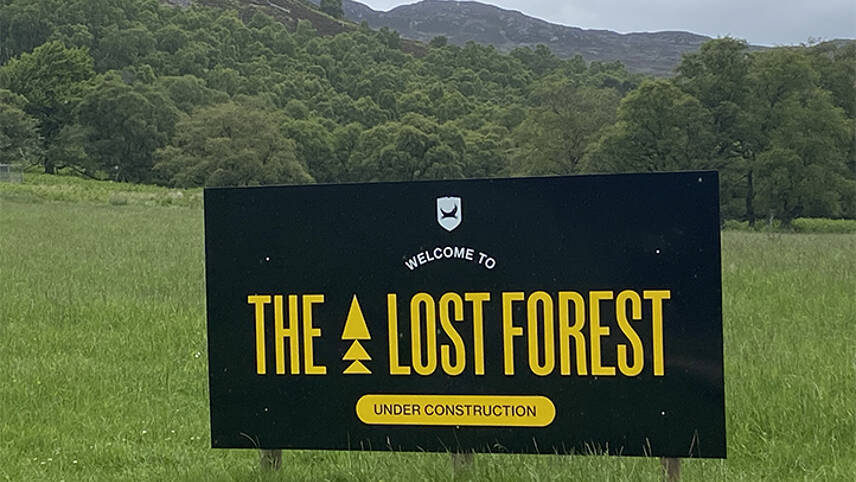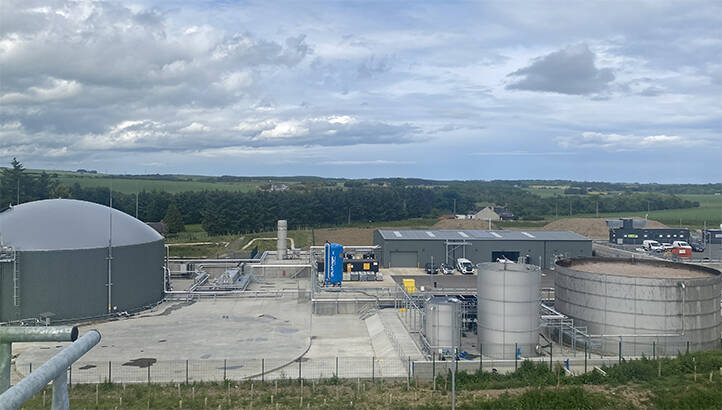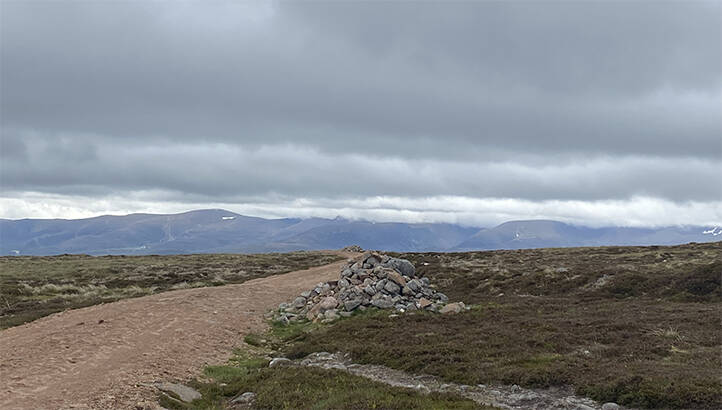Register for free and continue reading
Join our growing army of changemakers and get unlimited access to our premium content

“There are no non-radical solutions left,” BrewDog’s latest sustainability report – called Make Earth Great Again– states.
The company has built up a brand reputation of throwing out the rulebook to stand out from the crowd and get its message across – and that message has strongly focused on climate in recent years. Radical is normal for a company like BrewDog.
In true BrewDog fashion, getting that message across on its latest climate initiative has seen edie’s content editor Matt Mace dropped off in the heart of the Scottish Highlands. A taxi (all travel has been double offset as per company standards) takes a small team of journalists across the rolling hills of the countryside, past ancient forests, secluded lochs and mountain trails to the site of BrewDog’s headline-grabbing “Lost Forest”.
The Lost Forest encapsulates more than 9,300 acres of Scottish highlands at the Kinrara estate – which BrewDog claims is “bigger than 17 actual countries” – and looks set to form one of the UK’s largest native woodland and peatland restoration projects and the largest corporate-backed initiative of its kind.
The Lost Forest is currently “under construction”. Flanked by BrewDog’s director of sustainability Sarah Warman and Neil Crookston, who is regional manager for Scottish Woodlands – the firm overseeing the “construction” – we are taken across a craggy path that loops round a former bloodsport site, one that is notably absent of trees.
Lone pine and oak trees stand isolated on hilltops, the last remnants of a massive blanket of woodland that has since been whittled away by centuries of land management. BrewDog is essentially attempting to bring this “lost” woodland back.
“This is all going to be reforested,” Crookston says with a wave of a hand that passes over the barren hills and ditches in Kinrara. “Some will be left open for other restoration like peatland and in the areas of elevation it is less suitable to plant trees because of the wind and we want the trees to have the best chance of success.”

Scottish Woodlands’ regional manager Neil Crookston on site at the Lost Forest
“There’s a lot of matching in terms of tree stock and we have strict criteria for local providence and seeds for different types of elevation. It’s quite a detailed plan when you start putting all of these components together,” Crookston adds, likening the work to a mosaic of biodiversity.
Over the next five years, BrewDog aims to plant 1.1 million trees, creating a rich and vibrant biodiverse woodland ecosystem. Currently, it’s all very Jurassic Park (including the 4x4s used to wheel us across the estate). It’s a big-money venture to bring back something that has long since been lost, but instead of dinosaurs, I’m examining damaged peatland and cotton grass. The plans for BrewDog to add an eco-tourism hotspot, adventure sports and an onsite distillery only add to this park-like conjuration of what these idyllic yet barren hills could be turned into.
Yet there is a huge climate implication to this initiative. Peatlands are the largest carbon stores in the UK that, when healthy, can soak up carbon “indefinitely”, with trees also acting as carbon sequestering assets.
BrewDog’s Warman adds that they want to “make sure the right tree is in the right place” and with approval now officially granted to plant new woodland across 300 hectares and restore 100 hectares as well, this process can now start to take shape.
Phase 1 of the Lost Forest project has already seen 140 hectares of peatland restored through a “heavy process”, as Crookston puts it, that has mapped every hectare and met stringent government requirements. Following extensive feedback and consultations with neighbouring communities and estates, the Lost Forest can start its reincarnation.
Punk and persistence
Creating a forest from scratch is simultaneously very on-brand for BrewDog and also the antithesis of its quick, near-instant and full-frontal initiatives to combat the climate crisis that has seen its Lost Lager brand claim that each pack sold would fund a tree at the Lost Forest.
But while BrewDog’s mantra on climate action has been one of rapid delivery – discussions about the forest first took place internally in April 2020 with the land purchase taking place the same year – the actual delivery of the Lost Forest will be slow and meticulous.
About one-third of the land purchased at Kinrara will be dedicated to new woodland, with a large-scale peatland restoration project also set to feature. BrewDog had claimed that the Kinrara could capture up to 550,000 tonnes of CO2, a figure that has since been adjusted by the company to one million tonnes over the next 100 years, which an extremely long horizon to scan for a company that is just 15 years old.
Offset minefields
The Lost Forest taps into BrewDog’s “no non-radical left” approach to sustainability and the climate crisis.
The brewer has constantly grabbed the headlines – for the right and wrong reasons – and has made an industry-leading commitment to remove twice as much carbon from the air each year as it emits, with the first year of this being achieved being August 2020 through August 2021.
BrewDog announced that it has started offsetting more emissions than it generates across Scope 1 (direct), Scope 2 (power-related) and upstream Scope 3 (indirect) sources.
The forest and peatland in Scotland alone will not sequester twice as much carbon as BrewDog generates. To that end, the company is also funding other nature-based offsetting projects in the UK through The Woodland Trust and The Ribble Rivers Trust, as well as projects overseas through the Nature Conservancy of Canada and Australia’s Carbon Neutral Gold Standard.
But the company is keen to showcase its more traditional approaches to decarbonisation as well.
BrewDog has also arranged for our group to be transported to their headquarters and brewery in Ellon, just outside of Aberdeen – a two-hour drive from the Lost Forest site. BrewDog has taken journalists there to formally unveil its £12m bio-energy plant, which will see emissions at the brewery reduced by 7,500 tonnes annually once it is running at full capacity later in the year. It is here where I am finally able to sit down with Warman and the company’s co-founder James Watt to discuss the Lost Forest in more detail.

Brewdog’s new anaerobic digestor
According to reports, BrewDog has applied for funding for the first phase of the £8.8m Lost Forest, which could equate to £1.25m. However, this will just scratch the surface of the project, which BrewDog is mainly funding itself, with additional costs set to occur due to consultancy fees and the culling of more than 100 deer to stop tree saplings being grazed.
Watt states that the upfront cost of the Lost Forest is “significantly higher” than the reported £8.8m fee, but that the company isn’t looking to generate a return on investment for the ambitious and long-lasting project.
“As soon as we got stablised during the pandemic we decided that we had to pivot our business model to align more towards sustainability,” Watt tells edie.
“We very soon came to realise that we are facing an existential climate crisis and huge changes needed to be made, note in 2050 or 2030, but today. It’s okay for this business to fail, but it’s not okay for this planet to fail. I’d rather be in a position where we explored all we could, so there’s no economic aspect to this for us.”
For Watt, the bio-energy plant that is viewable from across the road is a prime example of how BrewDog is prioritising reductions primarily, even though it tends to be the double offset initiative that grabs more headlines.
Watt sits comfortably in his office as he explains BrewDog’s overarching approach to radical sustainability was inspired by a dinner with Sir David Attenborough and sculpted by external guidance from renowned sustainability expert and carbon footprint researcher Professor Mike Berners-Lee and his consultancy to “turbo-charge” a carbon reduction plan that aims to reduce emissions per pint by 40% within the next 12 months.
Burners-Lee and his team are the ones who help inform BrewDog about which partners are suitable to help with the double offsetting goal, but Watt notes that the Lost Forest will give the company much better ownership of the benefits that largescale offsetting projects can bring.
“We looked at some other options and the initial strategy wasn’t to own a forest,” Watt says. “But we became so disillusioned with the majority of removal and offset options on the market and we just felt there was just so much smoke and mirrors in this space and full of opportunistic charlatans.
“While there are some fantastic people in that space as well, it felt like a minefield and was so difficult and challenging, so why not own the problem and do what we can to fix it ourselves?”
Culture and climate
The Lost Forest isn’t the only thing to have undergone a transformation at BrewDog. Back in 2019 the company was lauded as a disrupter – a radical approach to branding, marketing and purpose, including a unique and unapologetic voice has seen it labelled as the UK’s fastest-growing food and drinks company, with an average annual growth of 167%.
However, recent allegations over a “toxic” workplace environment at the Aberdeenshire-based brewing company has harmed this reputation, and given the interlinks between social and environmental sustainability, some of the hype around this disruptive brand and its approach to climate action has cooled.
BrewDog has moved to rectify these claims about culture. The company has announced plans to hand out share worth more than £120,000 to staff over a four-year period and to launch a “profit-sharing scheme”. Indeed, chief executive Watt has claimed he would hand over almost one-fifth of his stake in the firm to employees.
Watt, however, believes that the employees are keen to be involved in the company’s overarching efforts to reduce emissions across its operations.
“I think everyone needs to become acutely aware of how stark the problem is,” he adds. “We’re facing an existential climate crisis that is only worsening. There’s still a window to change this and radical action is required on our watch. We’re in a precarious predicament that requires action.
“We’ve got different sustainability groups across our business and it can’t just be a top-down approach. The whole company has to come with us on this journey.”
Watt explains that the B-Corp certified company has partnered with PawPrint to enable employees to reduce their own personal footprints in a way that gamifies the process. Warman adds that a “Planet-First Forum” has been introduced across all key departments to gather solutions to drive down emissions. One such result from this process was the decision to pre-crush aluminum cans before they are collected for disposal to reduce the number of vehicles required to transport the material for recycling and reuse.
Warman has diligently accompanied journalists across the Lost Forest and on a tour of the Ellen brewery, in which co-founder Martin Dickie acted as the tour guide. When I finally got a chance to quiz her on double offsetting approaches, she is quick to point out the efforts taken to reduce emissions first and foremost, which in turn decreases the amount of offsets required.
These include investments in direct connections with three 800kW wind turbines right next to the brewery, powering the facility with 2.4MW of clean energy and covering all of its energy needs.
As well as rolling out its first company electric vehicle, the brewer has also started delivering beer across London in a 19-tonne EV. The company has also reported a boost to energy efficiency, with usage being reduced by more than 26% compared to 2016.
BrewDog and Warman have also done the math on its carbon offsetting approach. Since it began “double removing” carbon emissions in August 2020, the company has had to removed almost 2,900 tonnes of CO2e for each of the 19 weeks remaining in 2020 – equating to almost 55,000 tonnes. The company actually went and removed almost 60,000 tonnes “just to be on the safe side”.
While this is a manageable cost now, prices for carbon offsetting could reach highs of up to $120 per tonne by 2050, up from between $2 and $3 in 2021, BloombergNEF (BNEF) is forecasting. This creates a dilemma for a company that has leaned heavily on the offsets market and is one of the reasons why the Lost Forest has taken shape.
“We’re not sure where [offsetting scenarios] will land, so at the moment there’s no immediate action, but we’re cognizant of the fact that this space is becoming challenging in terms of getting into the right position and from a cost perspective as well,” Warman tells edie.
“Emissions reduction is the core principle of our strategy and driving them down as much as possible. It’s the main thing we’re focusing on at the end of the day. Scope 3 is the biggest piece of that pie and is a massive focus for us. We’ve been working with our suppliers and looking at our top 20 in terms of revenue to work directly with them to reduce emissions and we’re looking at what initiatives suppliers have to really help us.”
It will be decades before the Lost Forest begins to take shape, and even longer before widescale carbon sequestration benefits will begin to be felt. But during this whirlwind 24-hours in Scotland it is clear that this “statement” project is aimed at pushing the boundaries of what is possible for corporates in response to the climate crisis. There are no non-radical solutions left, and if companies don’t start reimagining what is possible, there might not be a liveable planet left once we’re done carrying on with business-as-usual.




Please login or Register to leave a comment.